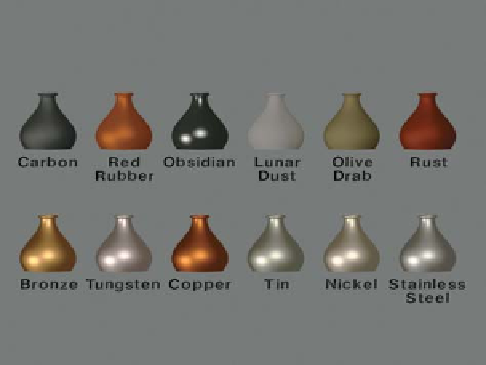Graphics Reference
In-Depth Information
Figure 27.15: A single vase, illuminated by two lights, made of 12 different materials whose
reflectance properties were determined with the Cook-Torrance model. (Courtesy of Robert
Cook, ©1981 ACM, Inc. Reprinted by permission.)
surface roughness means that even when we are looking near a silhouette,
some
parts of the surface are facing back toward us, and thus reflect more light than
might be expected (see Figure 27.16). In particular, they apply essentially the
Torrance-Sparrow-Cook idea of microfacets, but in a situation where they assume
that each microfacet acts like a
Lambertian
reflector rather than a mirror.
Figure 27.16: (Top) Near the
edge of a smooth diffuse sur-
face, very little light would be
scattered back toward the viewer
because the off-normal incidence
of the light makes the irradiance
small. (Bottom) If a small piece of
surface near the silhouette is ori-
ented more perpendicular to the
incident light direction, this sur-
face piece will scatter much more
light in all directions, includ-
ing the direction back toward the
viewer.
Furthermore, they consider not only single-bounce interactions of illumination
with microfacets, but multiple inter-reflections, observing that for a quite rough
surface, illuminated at a nearly grazing angle and viewed from the opposite side
from the illumination, each lighted facet is invisible to the viewer, but the facets
that are
not
directly lit may nonetheless be visible. If you look east toward a moun-
tain range at dawn, you cannot see the sunlight on the east sides of each mountain,
but the
west
side of some mountains will be illuminated by light reflected from
the east side of more westerly mountains (see Figure 27.17).
The expression for the radiance (assuming a Gaussian distribution of facet
slopes) from a facet is a rather messy integral. Oren and Nayar evaluated this inte-
gral for many different directions of arriving light, viewer direction, and Gaussian
shape parameters, and developed a much simplified form that's suitable for more
rapid computation of approximately correct values. The result is given in terms
of
,the
difference in azimuth between the incoming and outgoing light. If light arrives
from the west and leaves to the east, then
θ
i
, the angle between
v
i
and
n
,
θ
o
, the angle between
v
o
and
n
, and
φ
φ
=
0; if it leaves to the northeast, then
=
45
◦
; if it leaves to the southeast, then
45
◦
, etc. The model has two
φ
φ
=
−
σ
parameters: the slope-distribution constant
, where the probability of a facet at
2
−
θ
angle
θ
is proportional to
exp(
2
)
, and the albedo,
ρ
, of the surface (which may
2
σ
be a function of wavelength).
The full-generality result is seldom used; instead, the simplified version, which
accounts for only single scattering, is
Figure 27.17: The west sides of
mountains illuminated by the ris-
ing sun will be in shadow, but
may be lit by light reflected from
the east sides.
)=
ρ
π
L
r
(
θ
i
,
θ
o
,
φ
;
σ
E
0
cos(
θ
i
)(
A
+
B
max(
0,
cos
φ
)sin
α
tan
β
)
, where
(27.40)





























